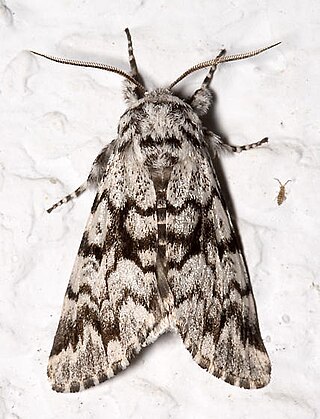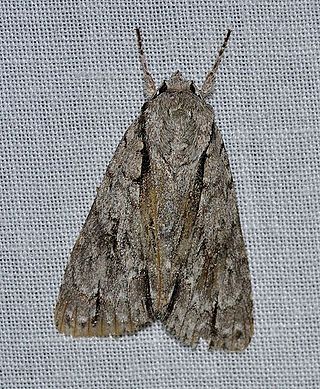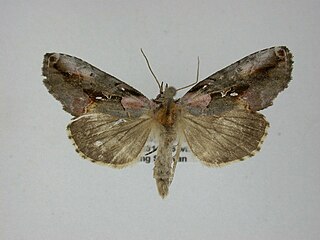
Schinia, commonly called flower moths, is a large genus of moths belonging to the family Noctuidae. The genus has a Holarctic distribution with the vast majority of species being found in North America, many with a very restricted range and larval food plant.
Afotella is a monotypic moth genus of the family Noctuidae erected by William Barnes and Foster Hendrickson Benjamin in 1926. Its only species, Afotella cylindrica, was first described by Augustus Radcliffe Grote in 1880. It is found in western North America from Saskatchewan and Alberta south to California.

Antivaleria is a genus of moths of the family Noctuidae. The genus was erected by Shigero Sugi in 1958.

Feltia is a genus of moths of the family Noctuidae.

Feralia is a genus of moths of the family Noctuidae. The genus was erected by Augustus Radcliffe Grote in 1874.

Panthea acronyctoides, the black zigzag or tufted spruce caterpillar, is a moth of the family Noctuidae. The species was first described by Francis Walker in 1861. It is found in North America from Newfoundland to British Columbia and adjacent northern states, south in the west to Colorado, south in the east to New England and Kentucky.
Abagrotis nefascia is a moth of the family Noctuidae first described by Smith in 1908. It is found in North America from Alberta and British Columbia down through Massachusetts to California. The species is listed as threatened in the US state of Connecticut.

Abagrotis orbis, the well-marked cutworm or Barnes' climbing cutworm, is a moth of the family Noctuidae. The species was first described by Augustus Radcliffe Grote in 1876. It is in southwestern North America, extending eastward across the plains and with a large disjunct population in dune habitats in the southern Great Lakes area. It extends into western Canada only in the southern interior of British Columbia and southern Alberta and Saskatchewan.

Acronicta hasta, the forked dagger moth, speared dagger moth, cherry dagger moth or dart dagger moth, is a moth of the family Noctuidae. The species was first described by Achille Guenée in 1852. It is found in North America in the eastern deciduous woodlands, ranging west across southern Saskatchewan and Alberta into central southern British Columbia, south to Tennessee, Wisconsin and Kansas.

Acronicta impressa, the impressive dagger moth or willow dagger moth, is a moth of the family Noctuidae. The species was first described by Francis Walker in 1856. It is found from western Canada to north-western Mexico.

Autographa sansoni, the Alberta beauty, is a moth of the family Noctuidae. The species was first described by F. H. Wolley Dod in 1910. It is found in the western mountains of North America, from Alaska south to Oregon, Idaho and Arizona. Occurring mainly in the Pacific Northwest, it thrives in mid-to-high elevation conifer forest habitat, as well as some areas of coastal rain forest in the Coast range. However, it is also found in a non-contiguous range in sub-alpine forest in the Rocky Mountains, ranging from Alberta in the north, to New Mexico in the south. The wingspan of an adult ranges between 34 and 36 mm. It is widespread, and a relatively common species.
Hypocoena inquinata, the sordid wainscot or tufted sedge moth, is a moth of the family Noctuidae. The species was first described by Achille Guenée in 1852. It is found across Canada from Newfoundland to British Columbia, south in the east to Connecticut and Ohio and in the west to Colorado.

Feltia jaculifera, the dingy cutworm, is a moth of the family Noctuidae and is common throughout North America. There are three other species of Feltia that are often confused for F. jaculifera and they are F. herilis, F. subgothica and F. tricosa.
Chrysanympha formosa, the Formosa looper, is a moth of the family Noctuidae. The species was first described by Augustus Radcliffe Grote in 1865. It is found in North America from Newfoundland west to Manitoba and south to the mountains of North Carolina and Tennessee.

Eosphoropteryx thyatyroides, the pink-patched looper moth or pink-tinted beauty, is a moth of the family Noctuidae. The species was first described by Achille Guenée in 1852. In North America it is found from Nova Scotia and northern Ontario south to Minnesota, Michigan, Ohio and along the Appalachians from Maine to eastern Tennessee and western North Carolina; and to the west, it occurs from central Alberta and southern British Columbia, south in the Cascades to southern Oregon, and in the Rocky Mountains to northern Idaho.

Euxoa comosa, the hairy euxoa moth, is a moth of the family Noctuidae first described by Herbert Knowles Morrison in 1876. It is found in western North America, except the Pacific coast, ranging east through the northern Great Plains, and in the Hudsonian zone to the Atlantic Ocean. It is found in every province and territory of Canada, except Nunavut.

Craniophora praeclara is a moth of the family Noctuidae. Its distribution includes North Korea, Japan, China, and the Russian Far East.
Feltia evanidalis is a species of cutworm or dart moth in the family Noctuidae. It is found in North America.
Feltia mollis is a species of cutworm or dart moth in the family Noctuidae. It is found in North America.
Feltia inyoca is a species of cutworm or dart moth in the family Noctuidae. It is found in North America.











